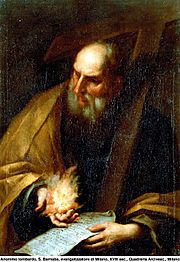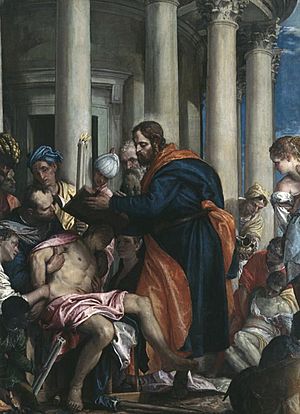Barnabas facts for kids
Quick facts for kids Barnabas |
|
|---|---|
| Apostle and Bishop of Milan | |
 |
|
| Church | Early Church |
| Metropolis | Milan and Cyprus |
| See | Milan and Cyprus |
| Successor | St. Anathalon of Milan |
| Personal details | |
| Born | Salamis, Roman Cyprus |
| Died | Salamis, Roman Cyprus |
| Alma mater | School of Gamaliel |
| Sainthood | |
| Feast day | June 11 |
| Venerated in |
|
| Canonized | Pre-Congregation |
| Attributes | Red Martyr, Pilgrim's staff; olive branch; holding the Gospel of Matthew |
| Patronage | Cyprus, Antioch, against hailstorms, invoked as peacemaker, peacekeeping missions |
| Shrines | Monastery of St Barnabas in Famagusta, Cyprus |
Barnabas was an important early Christian leader. He was born Joseph (or Joses) in Salamis, Roman Cyprus, and was a Jewish person from Cyprus. The Book of Acts in the Bible says the apostles gave him the name Barnabas, which means "son of encouragement" or "son of consolation." He is known as an apostle and traveled with Paul the Apostle on important missionary journeys. Together, they helped many non-Jewish people become Christians.
Barnabas's story is mainly found in the Acts of the Apostles in the Bible. Paul also mentions him in some of his letters. Christian tradition says that Barnabas was killed for his faith in Salamis, Cyprus. He is also believed to be the founder of the Cypriot Orthodox Church. Christians celebrate his feast day on June 11. Barnabas is often thought to be the cousin of Mark the Evangelist.
Contents
Who Was Barnabas?
Barnabas was born Joseph, but the apostles in Jerusalem gave him the name Barnabas. This name means "son of encouragement" or "son of consolation." He was a Levite, which means he belonged to a special group of Jewish people who traditionally served in the Temple.
Barnabas in the Bible
Barnabas's story is mostly told in the Acts of the Apostles, a book in the Bible that describes the early Christian church.
His Generosity
Barnabas was first mentioned as a member of the early Christian community in Jerusalem. He showed great generosity by selling land he owned and giving all the money to the community. This act of kindness earned him his new name.
Meeting Paul
When Paul the Apostle (who was then called Saul) became a Christian and returned to Jerusalem, many people were afraid of him because he used to persecute Christians. Barnabas was the one who introduced Paul to the other apostles, helping them trust him. Some believe they might have studied together in the school of Gamaliel.
Missionary Journeys

The Christian message spread successfully to non-Jewish people in Antioch. The church in Jerusalem sent Barnabas there to help. He found the work so big that he went to Tarsus to find Paul and ask for his help. Paul joined him, and they worked together in Antioch for a year.
Later, Barnabas and Paul were sent to Jerusalem with money from the Antioch church to help poorer Christians in Judea. They returned to Antioch with John Mark, who was Barnabas's cousin or nephew.
Traveling Together
Barnabas, Paul, and John Mark then traveled to Cyprus and other cities like those in Pamphylia, Pisidia, and Lycaonia. During these journeys, Paul became the main speaker, and people sometimes thought he was the Greek god Hermes, while Barnabas was thought to be Zeus. This shows how powerful their message was.
The Jerusalem Council
After their first missionary journey, Barnabas and Paul went back to Jerusalem. They met with the church leaders there to discuss an important question: should non-Jewish people become Jewish before becoming Christians? The Council of Jerusalem decided that non-Jews could join the church without following all Jewish customs. Barnabas and Paul brought this good news back to Antioch.
A Disagreement
Later, Paul asked Barnabas to go on another journey. Barnabas wanted to take John Mark with them again, but Paul disagreed because John Mark had left them on the earlier trip. This disagreement was so strong that Paul and Barnabas decided to go separate ways. Paul took Silas with him, and Barnabas took John Mark to visit Cyprus.
Even though they separated, their friendship remained strong. Paul later mentioned Barnabas in his letters, showing they still respected each other.
Barnabas and Antioch
Antioch, a very important city in the Roman Empire (now Antakya, Turkey), was where followers of Jesus were first called "Christians." Barnabas played a key role in the early Christian community there. The church in Antioch was generous and helped the poorer church in Jerusalem.
His Death
| Saint Barnabas |
|
|---|---|
 |
|
| Apostle, Disciple, Preacher, and Martyr | |
| Born | 1st century AD Salamis, Roman Cyprus |
| Died | Salamis, Roman Cyprus |
| Venerated in | Catholic Church, Eastern Orthodox Churches, Oriental Orthodox Churches, Anglican Communion, Lutheran Church |
| Canonized | Pre-Congregation |
| Major shrine | Monastery of St Barnabas in Famagusta, Cyprus |
| Feast | June 11 |
| Attributes | Red Martyr, Pilgrim's staff; olive branch; holding the Gospel of Matthew |
| Patronage | Cyprus, Antioch, against hailstorms, invoked as peacemaker |
Christian tradition says that Barnabas was killed for his faith in Salamis, Cyprus. It is said that some people who were upset by his preaching attacked him in the synagogue, dragged him out, and killed him. His cousin, John Mark, secretly buried his body.
Centuries later, in 478 AD, it is believed that Barnabas appeared in a dream to the Archbishop of Cyprus, Anthemios. Barnabas showed him where his tomb was, under a carob tree. The next day, Anthemios found the tomb and inside it were Barnabas's remains, along with a copy of Matthew's Gospel on his chest. This discovery helped the Cypriot Orthodox Church gain special recognition.
Today, St. Barnabas is honored as the patron saint of Cyprus. He is also a patron saint in other places, like Milan in Italy.
Writings Connected to Barnabas
Some ancient writers believed that Barnabas wrote the Letter to the Hebrews in the Bible, but most modern scholars do not agree.
There is also an ancient book called the Epistle of Barnabas. Some early church leaders thought Barnabas wrote it, and it was even included in one of the oldest complete New Testament manuscripts, the Codex Sinaiticus. However, many modern experts believe it was written by someone else in the 130s AD.
Another book, called the Gospel of Barnabas, appeared much later. This book is different from the traditional Christian Gospels. It says that Jesus was a prophet, not the Son of God. This book is not accepted by Christian churches.
The Barnabites
In 1538, a Catholic religious group officially named "Clerics Regular of St. Paul" made the old Monastery of Saint Barnabas in Milan their main home. Because of this, the group became popularly known as the Barnabites.
Images for kids
-
Saints Paul and Barnabas at Lystra (Sacrifice at Lystra) by Bartholomeus Breenberg, 1637, Princeton University Art Museum
See also
 In Spanish: Bernabé apóstol para niños
In Spanish: Bernabé apóstol para niños
- Catholic Church in Cyprus
- List of early Christian saints


